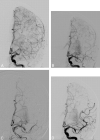Stent placement for flow restoration in acute ischemic stroke: a single-center experience with the Solitaire stent system
- PMID: 21596812
- PMCID: PMC7966073
- DOI: 10.3174/ajnr.A2505
Stent placement for flow restoration in acute ischemic stroke: a single-center experience with the Solitaire stent system
Abstract
Background and purpose: In acute thromboembolic stroke, mechanical recanalization with stents may result in immediate flow restoration. The Solitaire stent can be used both for flow restoration and thrombectomy. In this single-center experience, we report safety and efficacy data on the application of the Solitaire stent.
Materials and methods: Between March 2009 and July 2010, 18 patients were treated with the Solitaire stent. To evaluate perfusion of the occluded vessel segment before and after the intervention, the TICI score was used (0-3). Clinical outcome was assessed by using the mRS at discharge.
Results: Overall, recanalization was successful in 16 of 18 patients (88.8%). There were no procedure-related complications. Mean TICI score after the intervention was 2.3 ± 0.8. In 5 patients, reocclusion of the treated vessel occurred immediately after retrieval of the temporarily opened stent, and permanent stent deployment was performed to maintain stable perfusion. In 3 patients, hemorrhage occurred after successful recanalization. Five patients died (infarction, n = 3; hemorrhage, n = 1; organ failure, n = 1). A good clinical outcome (mRS ≤2) was achieved in 33.3% of the patients, 5.5% had a moderate outcome (mRS, 3/4), and 61.2% had a poor outcome or died (mRS, 5/6).
Conclusions: Application of the Solitaire stent in acute stroke results in a high recanalization rate (88.8%) without procedural complications and with a good outcome in one-third of patients. These results encourage further evaluation of the stent in larger patient populations.
Figures

References
-
- Rha JH, Saver JL. The impact of recanalization on ischemic stroke outcome: a meta-analysis. Stroke 2007;38:967–73 - PubMed
-
- Furlan A, Higashida R, Wechsler L, et al. . Intra-arterial prourokinase for acute ischemic stroke. The PROACT II study: a randomized controlled trial. Prolyse in acute cerebral thromboembolism. JAMA 1999;282:2003–11 - PubMed
-
- Smith WS, Sung G, Saver J, et al. . Mechanical thrombectomy for acute ischemic stroke: final results of the Multi MERCI trial. Stroke 2008;39:1205–12 - PubMed
-
- The Penumbra pivotal stroke trial: safety and effectiveness of a new generation of mechanical devices for clot removal in intracranial large vessel occlusive disease. Stroke 2009;40:2761–68 - PubMed
Publication types
MeSH terms
LinkOut - more resources
Full Text Sources
